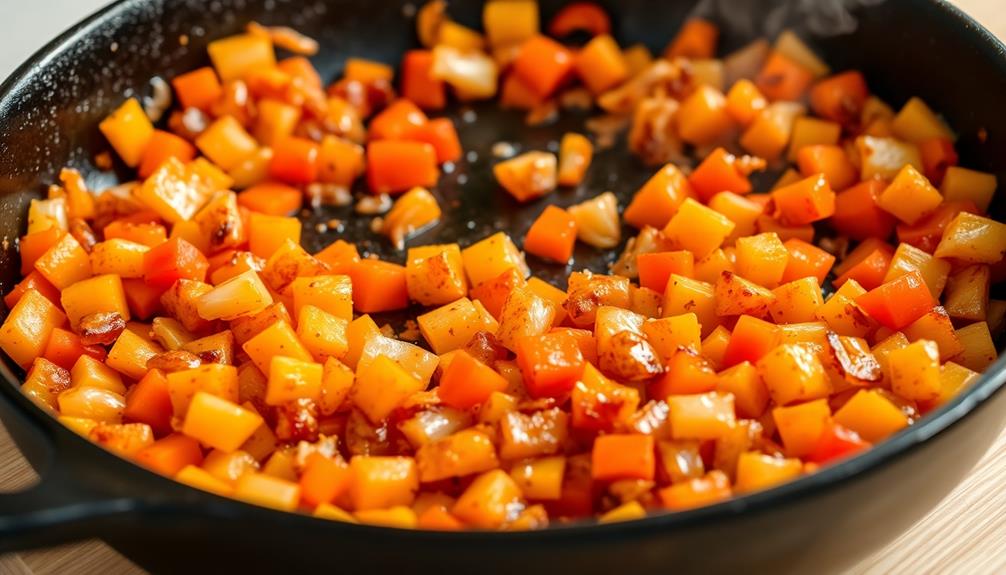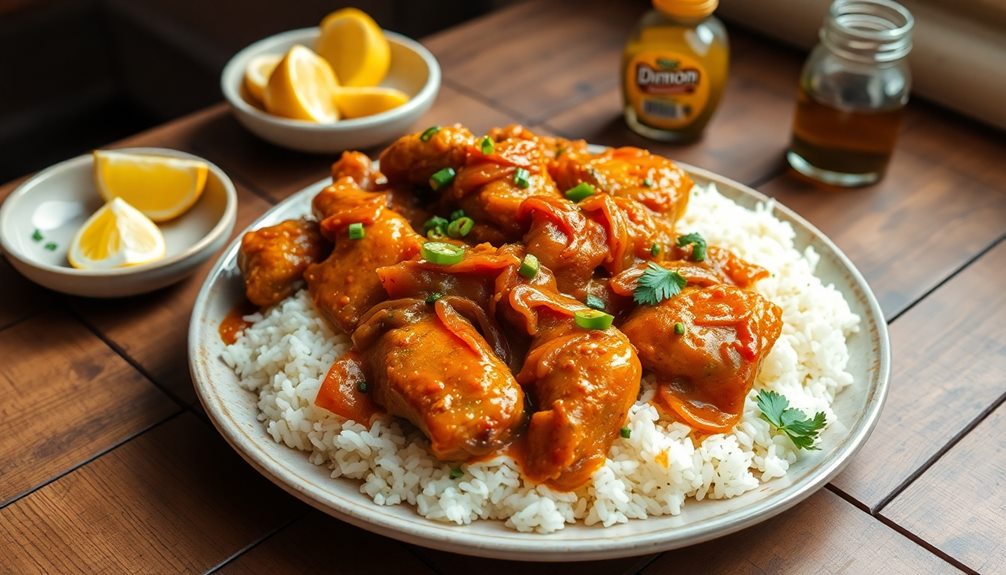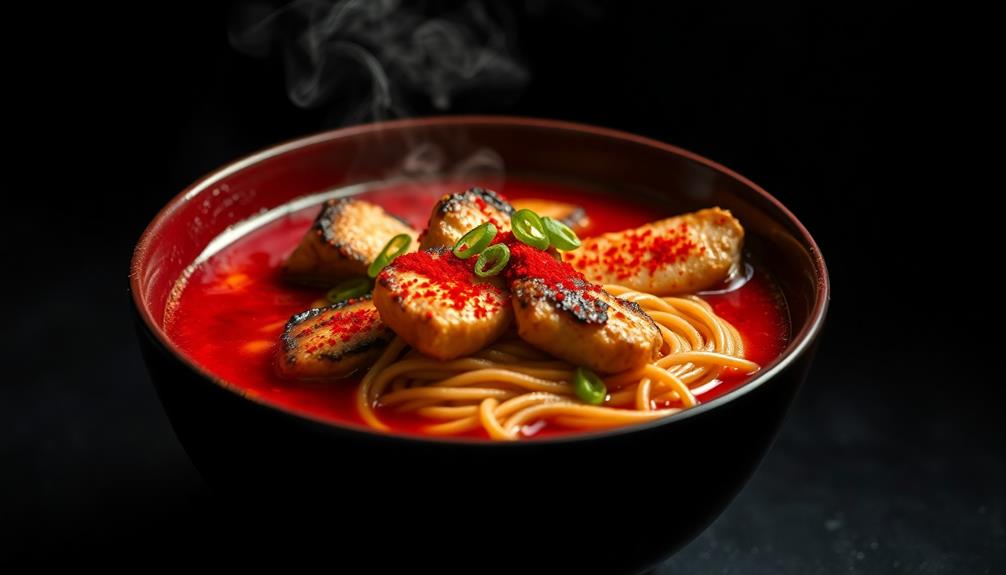The Maillard reaction is the exciting science behind the delightful browning and incredible flavors that happen when you cook foods. It was discovered over 100 years ago, and it's what gives your favorite baked goods, roasted meats, and seared veggies that incredible aroma and taste. This complex chemical process transforms simple ingredients into a symphony of mouthwatering flavors that can elevate your home-cooked meals to gourmet-level deliciousness. You'll learn the key steps to mastering the Maillard reaction and discover how it can expand your culinary creativity – so get ready to unlock a world of delicious possibilities!
Key Takeaways
- The Maillard reaction is a complex chemical process that occurs when proteins and sugars are heated, responsible for browning and flavor development in cooked foods.
- This reaction was discovered in 1912 by French chemist Louis-Camille Maillard and is essential for enhancing flavors in a wide range of cooked dishes.
- The Maillard reaction creates hundreds of unique flavor compounds, which are key to achieving the desirable taste, aroma, and appearance in roasted meats, baked goods, and other cooked foods.
- Proper techniques, such as maintaining high cooking temperatures, avoiding overcrowding, and monitoring color changes, are crucial for maximizing the Maillard reaction and achieving optimal browning.
- Mastering the Maillard reaction can elevate home-cooked meals to a restaurant-quality level, expand culinary creativity, and provide a deeper understanding of the science behind cooking.
History
The Maillard reaction was first discovered in 1912 by French chemist Louis-Camille Maillard. He was studying the reactions between amino acids and sugars, and he noticed that when these two ingredients were heated together, they produced a brown color and a delicious aroma. This was the beginning of the Maillard reaction, a process that happens when foods are cooked or baked.
The Maillard reaction is named after Maillard, but it's actually a series of chemical reactions that occur between amino acids and sugars. As the food is heated, these two components react and create hundreds of different flavor compounds.
This is what gives bread, coffee, and many other cooked foods their wonderful, complex flavors. The Maillard reaction is an important part of cooking, and it's one of the reasons why food tastes so much better when it's been cooked or baked.
Recipe
The Maillard Reaction is a chemical process that occurs when food is cooked at high temperatures, resulting in the development of hundreds of different flavor compounds. This reaction is responsible for the delicious, savory, and often complex flavors found in roasted meats, baked goods, and many other dishes.
By understanding the importance of a well-structured cooking process, we can optimize our culinary endeavors and fully experience the Maillard reaction music production workflow.
To fully experience the Maillard reaction, we'll be making a classic roasted chicken dish. This simple yet flavorful recipe will allow the Maillard reaction to shine, creating a beautifully browned and crispy skin, and a tender, juicy interior.
- 1 whole chicken (4-5 lbs)
- 2 tbsp olive oil
- 1 tsp salt
- 1/2 tsp black pepper
- 1 tsp dried thyme
- 1 tsp dried rosemary
Preheat your oven to 425°F (220°C). Pat the chicken dry with paper towels and rub the entire surface with the olive oil. Season the chicken generously with salt, pepper, thyme, and rosemary, making sure to get the seasoning under the skin as well.
Place the chicken in a roasting pan or on a baking sheet. Roast the chicken for 60-75 minutes, or until the internal temperature reaches 165°F (75°C) in the thickest part of the thigh. Allow the chicken to rest for 10 minutes before carving and serving.
To ensure the best results, make sure to thoroughly pat the chicken dry before seasoning. This will help facilitate the Maillard reaction and create that beautiful, crispy skin.
Additionally, basting the chicken with the pan juices during the cooking process can further enhance the browning and flavor development.
Cooking Steps
Preheat your oven to 400°F, then toss those veggies with a drizzle of oil, a sprinkle of salt, and a dash of pepper.
Now, pop them in the oven and roast until they're nicely browned.
Don't forget to flip them halfway through so they can caramelize to perfection!
Step 1. Preheat Oven to 400°F

Preheating your oven to 400°F is a crucial step in many recipes, as it ensures your dish cooks evenly and efficiently.
Once you've gathered all your ingredients and prepped your kitchen, it's time to turn on that oven! Turning the dial to 400°F gets your oven nice and toasty, ready to bake up something delicious.
As the temperature climbs, you'll start to smell the enticing aroma of your meal-to-be. The warming oven creates the perfect environment for that Maillard reaction to work its magic, producing mouthwatering, golden-brown results.
Additionally, ensuring you have fresh ingredients, like high fiber and vitamin content from vegetables, can enhance the overall flavor of your dish.
Whether you're baking cookies, roasting veggies, or making a casserole, that preheat step is key. So don't skip it!
Letting your oven fully preheat ensures your food cooks through perfectly, with a crisp outside and a tender, flavorful inside.
Soon, you'll be pulling a freshly baked treat from the oven, ready to enjoy the fruits of your labor. Mmm, can you already smell it?
Step 2. Toss Vegetables With Oil, Salt, Pepper

After preheating your oven, you can now toss your vegetables with oil, salt, and pepper. This simple step is key for bringing out the most delicious flavors in your veggies!
First, grab a big bowl and add your chopped vegetables. Drizzle them with a few tablespoons of olive oil, then sprinkle on some salt and freshly ground black pepper.
Using quality ingredients like unsalted butter can enhance the richness of your dish, so consider adding a bit of melted butter for extra flavor. Use your hands to toss everything together until the veggies are evenly coated. The oil helps the seasonings stick, while also promoting that irresistible browning in the oven.
You'll smell those veggies roasting and practically see the caramelization happening! Once they're all dressed up, spread the vegetables out in a single layer on a baking sheet.
Now they're ready to slide into the hot oven and transform into something truly mouthwatering. Just wait until you take that first bite – the Maillard reaction has worked its magic!
Step 3. Roast Vegetables Until Browned

With your vegetables prepped and seasoned, it's time to pop them in the oven. You'll want to preheat your oven to a nice, hot temperature – around 400°F (200°C) should do the trick.
Spread your veggies out in a single layer on a baking sheet or roasting pan. This allows them to get nice and crispy as they roast.
As the oven heats up, you'll start to smell an incredible aroma wafting through the kitchen. That's the Maillard reaction in action! The high heat causes the natural sugars and amino acids in the vegetables to react, creating hundreds of different flavor compounds.
This is what gives roasted veggies their signature caramelized, nutty taste.
Keep an eye on your vegetables, giving them a gentle toss halfway through. You'll know they're ready when they're beautifully browned and fork-tender.
Serve them up hot, savoring every delicious bite. The Maillard magic has transformed simple veggies into an absolute flavor sensation!
Step 4. Flip Vegetables Halfway Through Roasting

Halfway through the roast, give your veggies a gentle toss. This simple step unlocks a whole new layer of flavor!
When the vegetables are flipped, the uncooked sides are exposed to the intense heat of the oven, kickstarting the Maillard reaction. As the sugars and amino acids meet the dry, high heat, they dance together, creating those irresistible browning and caramelizing effects.
Tossing the vegetables ensures even cooking and, more importantly, even browning. You'll end up with a gorgeous array of golden-brown pieces that are crispy on the outside and tender on the inside.
The Maillard reaction enhances the natural sweetness of the veggies, making them taste more vibrant and delicious. So don't be shy – give those roasted gems a little flip halfway through for maximum flavor and texture. Your taste buds will thank you!
Step 5. Let Vegetables Caramelize Until Desired

Once you've flipped your vegetables halfway through the roasting process, let them continue caramelizing until they reach your desired level of doneness. As they bake, the sugars in the veggies will start to caramelize, creating a lovely golden-brown color and a delightfully sweet, nutty flavor.
You'll know they're ready when they're fork-tender and the edges have become wonderfully crispy.
Keep a close eye on them, giving them a gentle stir every few minutes. This will help them brown evenly and prevent any burning. The aroma wafting through your kitchen will be simply mouthwatering!
Once they've reached that perfect, caramelized state, remove them from the oven and serve them up hot. Your taste buds are in for a real treat. The combination of the tender, sweet veggies and the irresistible caramelized bits is simply divine.
Get ready to savor every bite!
Final Thoughts
The Maillard reaction is a complex process with far-reaching implications in the culinary world. When you cook foods like steak, bread, or vegetables, this reaction creates the mouthwatering aromas and delicious flavors we love.
It's the magic behind the golden-brown crust on a freshly baked loaf of bread or the savory sear on a juicy steak.
As you continue exploring the science of cooking, remember that the Maillard reaction is your friend. Mastering it can take your home-cooked meals to the next level.
Pay close attention to your food as it cooks, watch for those tantalizing color changes, and don't be afraid to let your veggies caramelize until they're perfect.
With a little practice, you'll be creating restaurant-quality dishes right in your own kitchen. The Maillard reaction is a culinary superpower just waiting to be unleashed.
Get excited and start experimenting – your taste buds will thank you!
Frequently Asked Questions
How Can the Maillard Reaction Be Used to Improve Food Texture?
You can use the Maillard reaction to enhance food texture by promoting browning and caramelization. This creates a crunchy, crisp, or chewy mouthfeel that adds complexity and depth to your dishes.
What Is the Role of Ph in the Maillard Reaction?
The pH level plays a crucial role in the Maillard reaction. It affects the reaction's kinetics, flavor profile, and the types of compounds formed. Typically, a slightly acidic or neutral pH promotes the Maillard reaction, resulting in improved food texture.
Can the Maillard Reaction Be Controlled in Commercial Food Production?
Absolutely! The Maillard reaction can be controlled in commercial food production. You can adjust factors like time, temperature, and pH to ensure the desired level of browning and flavor development in your products.
How Does the Maillard Reaction Affect the Nutritional Value of Food?
The Maillard reaction can affect the nutritional value of food by altering the bioavailability of certain nutrients, breaking down vitamins, and creating potentially harmful compounds. However, it can also enhance flavor and color, making the food more appealing.
Can the Maillard Reaction Be Replicated in Home Cooking Experiments?
Yes, you can replicate the Maillard reaction in your home kitchen. By searing meats, toasting bread, or caramelizing vegetables, you'll create delicious browned flavors through this natural chemical process.









